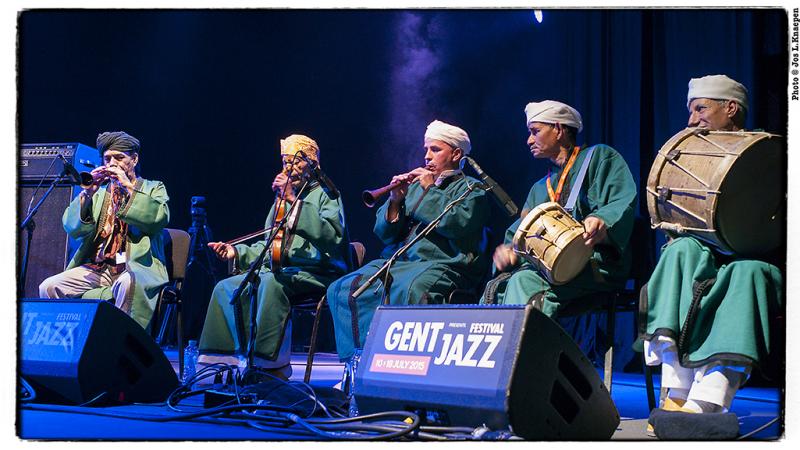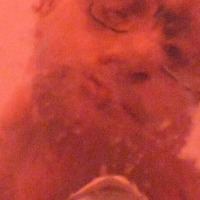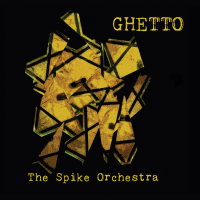Home » Jazz Articles » Live Review » Gent Jazz Festival 2015: Part 1
Gent Jazz Festival 2015: Part 1

Bijloke
Gent, Belgium
July 10-12, 2015
Part 1 | Part 2
A bold beginning was made with the festival's opening night, perhaps concentrating on some of director Bertrand Flamang's personal favourites. This evening was never destined to be a sell-out session, but its programming featured some of the most innovative, creative and, well, best exponents of the music worldwide. Earlier in the running order were a pair of young pianists who are quaking up the compositional and playing forms, in their completely different fashions: Kris Davis and David Virelles. Then, there was a Chicagoan summit, organised by drummer Jack DeJohnette, and featuring two of that windy city's greatest veteran musicians: another pianist, Muhal Richard Abrams, and reedsman Roscoe Mitchell, a prime guider of the Art Ensemble Of Chicago. To culminate, we had a completely different project, a collaboration between bassist Bill Laswell's current incarnation of Material with the famed Master Musicians of Jajouka from Morocco, led by Bachir Attar. That's a somewhat impressive spread, even if it turned out to be the least punter-populated night of the entire festival.
Infrasound is the latest band led by pianist Kris Davis, who was born in Vancouver but has long been resident in New York City. It's her most ambitious surround yet, with a front line that features four clarinets, for maximum tonal painting. That might be the most immediately notable feature, but the combo also facilitates other potential contrasts, particularly the face-off between the leader's acoustic piano and the frequently sullied sounds of organist Antoine Rayon. This nestling of textures is key to the paradoxical world of Infrasound, with Davis sometimes becoming equally jarring in her dogged hammer-chording, moving from peaceful probing to sudden minimalist repeats. Some of this music is amongst her most aggressive output, quite staggeringly so, but this imparts an even greater shock when calmness returns, and the clarinets unzip their soft underbellies. Rarely have lyrical beauty and sonic erosion co-existed so harmoniously. The album title tune, "Save Your Breath," was infected by spectral antichrist vibrations, with mass shadings and gradual development. There was a leap towards hyperactive rabble-babble, with growling surges and stabs, leading into a Mingus-ey rumble-roll, darting, complex clarinet lines grafted tight to complex drum patterns, courtesy of Tom Rainey.
Over at the Garden Stage, the Cuban pianist David Virelles made some less extreme gestures towards exploratory areas, rising out of the Afro-Latin tradition, but still resonating with abstract clusters of atonality. As is often the case on this stage, it took all three sets to steadily reach a pitch of excitement, this extended delivery allowing the artist to plot a gradual journey, even if it was alternated with the sets over on the main stage. For the final set, percussionist Román Díaz brought his voice to the fore, suggesting a calling-out to the Santerían orishás, contributing his deep Cuban sensibilities to the group sound, helping to shake up the distinctive Virelles avant Latin cocktail.
Jack DeJohnette was the figurehead for the Chicagoan quartet, touring to celebrate the 50th anniversary for the AACM (Association For The Advancement Of Creative Musicians), joined by a pair of eminent colleagues, Roscoe Mitchell and the organisation's co-founder, Muhal Richard Abrams. The lesser-known bassist Larry Gray completed the line-up. Their set opened with an extremely introverted stretch, DeJohnette having a qanun (Middle Eastern zither) as one of the sounds on his electronic pads, Gray switching to cello and Mitchell taking up the sopranino horn. There was a knife-edge between deep meditation and uneventful stasis, but after around 30 minutes, the foursome grew into a section that found Mitchell flying, grabbing energy around a logically escalating soprano solo, rippling with his cohorts in tow, DeJohnette making severe detonations as the climax gathered in force. A coalescing sense of urgency drove the set to its conclusion.
Bill Laswell led an incarnation of Material that included Graham Haynes (trumpet), Peter Apfelbaum (saxophones), Aiyb Dieng (percussion) and Hamid Drake (drums). They were joined by the Master Musicians Of Jajouka, in a five-piece manifestation headed by Bachir Attar. This was a very different set to follow on from the Chicagoans, mostly gyrating around a relentlessly trundling groove, flooded by Laswell's basslines, their tarry form acting as glue for the varied elements riding above. The Moroccans shone on their own, with violin played in rebab style, two rhaita reed-pipes and a pair of small drums, but when the Material mass loaded in, the nature of their sound was forced to change. On the one hand, they could have been given a longer introductory stretch, so that they could have been heard in their 'natural' acoustic state, but on the other, it was an early rush of excitement as the North African input vibrated in tandem with the altered funk of Material. Drake and Dieng were equally adept at laying down dense patterns and fragmenting into stray streaks, whilst the Haynes/Apfelbaum horns would reply to to the Moroccan reeds, providing an Americanised response to the heavy vibrato, answering in an equally strange soul-jazz language, and even weaving in a run of Prime Time Ornette Coleman, with whom the Jajouka clan had a continued link.
To wind down afterwards, back at the Garden Stage, old hand Dutch cellist Ernst Reijseger was partnered with the less familiar pair of pianist Harmen Fraanje and Senegalese multi-instrumentalist singer Mola Sylla, the latter of whom couldn't help but define the overall character of the music, although a chamber jazz tranquillity was also in evidence. It was perhaps a touch too relaxing, harmonious and lyrical, following the Laswell set, but perhaps this was needed following such an intensely ritualistic groove accumulation.
The second day boasted another classily classic line-up. The Vijay Iyer Trio represented a younger generation, although this pianist has established a deeply carved reputation in a very short time, at least when viewed in jazz years. Iyer is so experienced already that he naturally commands an attentive audience, blanketing them in a mostly inward-looking environment. He sprinkled repeating cycles in all directions, fertilised by Stephan Crump's nagging basslines. The leader operated down in the opalescent river tributary depths, streaming out a softly articulated form of froth-funk. "Starlings" offered a hymnal pause for reflection, at least initially. Then it rapidly gathered a stormy rumble. Currently, Iyer seems to be revealing a newfound love for The Necks, or maybe Dawn of Midi, those two generations of improvising structure-builders. Previously, he didn't play with such cyclic, accumulating repetition. This isn't the kind of systematic construction work that springs from Philip Glass and Steve Reich. Then, afterwards, he revealed that it was more Robert Hood that he had in mind, the minimal techno co-founder of Detroit collective Underground Resistance.
The next two artists should be viewed as co-headliners, a pair of the most august presences in jazz: Abdullah Ibrahim and Charles Lloyd. South African pianist Ibrahim chose to present his Mukashi trio, with Cleave Guyton (flute/clarinet) and Noah Jackson (cello/bass). He opened the set alone, delicately dappling, building a rhythm, immediately suggesting township jazz, then drifting into a hymnal section, assembling a medley of tunes. Flute and cello entered for a tightly constructed piece, sweetly melancholy, followed by a switch to just bass and piccolo flute, making chase, with Ibrahim sitting out. It was quite an achievement to present such skeletal, fragile music in front of several thousand folks, and to be followed by saxophonist Charles Lloyd, who also partially operated on similarly thoughtful ground. This was another themed evening, strangely serene, until Lloyd began to step up towards one of his most mainline jazz sets in recent memory.
Unlike the combo with Jason Moran, Reuben Rogers and Eric Harland, this new formation with Gerald Clayton (piano), Joe Sanders (bass) and Kendrick Scott (drums) facilitates a hardcore jazz path for Lloyd, with few diversions into other musical zones. Part of the atmosphere was polluted by Lloyd having a tantrum right at set's start, annoyed by the way the audience were straggling into the large marquee tent, searching for their seats. Maybe he'd just stepped off the tourbus, without surveying the scene, but this is the way of outdoor festivals, and it didn't take long for the crowd to get settled. Anyway, he marched the band offstage for a few minutes, to make a grumpy stand. At least he apologised at gig's end, once he'd realised how sensitive his audience actually was, and once there had been some highly charged musical passages essayed. So, it all turned out wonderfully in the end. Lloyd completely dominated, with a continual sequence of strong-voiced tenor solos, fuelled by an inventive mind, in tune with the jazz core, as if he's lately feeling nostalgic for his signature sound, from back in the early days. There was no fragility of the elder statesman here, unless Lloyd deliberately intended fragility. Mostly, though, he was set on tough, complicated streams of warm content, seething with a firm passion.
Across at the Garden Stage, the Dutch tenor man Yuri Honing's third set extended the evening's mood perfectly, which held the assembled (those spilling outside the tent, sitting around the grassy eating area) completely in thrall to a duo interlude with pianist Wolfert Brederode, breaking away from the core quartet formation. This was quite an amazing feat for 10pm on a Saturday night, after much beer, wine and cocktails had been supped, that day's audience was completely in tune with the mostly contemplative sounds of the chosen artists. This was the second day of programming that possessed an unusual character.
With the third day's headline act being the teaming of Tony Bennett and Lady Gaga, this also qualified as an atypical session, with ticket prices being quite costly, presumably making the afternoon's mainline jazz acts relatively inaccessible to folks who weren't committed to catching that evening's dynamic duo. Even if the Stephane Belmondo Trio's homage to Chet Baker was sparsely attended and lacking in focus and energy, by the time Bill Charlap's own threesome took to the stage, there was a fuller audience, and a steaming atmosphere, thanks to the pianist's overcharged attitude to performance, regardless of this being a supposedly relaxing afternoon slot. Charlap's showy, flamboyant delivery was packed with frilly and flowery showing-off, the leader injecting maximum decoration to his solo gushes. Bassist Peter Washington and drummer Kenny Washington were also coiled tight, but it was essentially Charlap's show. A fast run of popular chestnuts included a gleaming "In The Still Of The Night," leading a merry chase, with Charlap ready to roll hard, even at 5pm. He shot off harmonious speed-runs with a quicksilver grace, every number ending with an emphatic final slam (or even two). His soloing level could only be described as 'manic,' but there was a gentle reading of "Somewhere," even though this eventually began to alternate the diaphanous with the bombastic.
The joint was rammed by the time Bennett/Gaga climaxed the night. The prime observation to make is that the the collaboration was only partially integrated, with each singer having their own bands-within-a-band, facing off across the stage, with much emphasis on solo numbers, actual duets interspersed relatively sparsely. Given that their voices and personalities combined so naturally, this was puzzling, but perhaps there was a deliberate rationing and pacing strategy to the set's dynamics. Bennett sang "Stranger In Paradise," then Gaga delivered "Nature Boy," trilled with precision. Bennett answered with "The Good Life," then Gaga (looking like a blonde Judy Garland) swung through "Bewitched, Bothered And Bewildered," benefiting from a purring organ solo. Bennett offered "Smile" and "In My Solitude," Gaga re-joining for "I Can't Give You Anything But Love." Then Sinatra and Piaf were celebrated, a team of mathematicians on hand to tabulate Gaga's costume changes, as she swung her chain to "Let's Face The Music And Dance." The pair lifted up for the final fling of "The Lady Is A Tramp" and "But Beautiful." This collaboration was an ideal trade-off, with Bennett allowed to reach a younger crowd, Gaga gaining respect as an interpreter of the classic songbook. Surely the resultant audience is destined to be one of 2015's most amusingly mixed assemblages.
Photo Credit: Jos L. Knaepen
Tags
Live Reviews
Martin Longley
Belgium
Ghent
Kris Davis
David Virelles
Jack DeJohnette
Muhal Richard Abrams
Roscoe Mitchell
Art Ensemble of Chicago
Bill Laswell
Master Musicians of Jajouka
Tom Rainey
Larry Gray
Graham Haynes
Peter Apfelbaum
Aiyb Dieng
Hamid Drake
Ernst Reijseger
Vijay Iyer
Stephan Crump
The Necks
Dawn of Midi
Philip Glass
Steve Reich
abdullah ibrahim
charles lloyd
Cleave Guyton
Noah Jackson
jason moran
Reuben Rogers
Eric Harland
Gerald Clayton
Joe Sanders
Kendrick Scott
Yuri Honing
Tony Bennett
Stephane Belmondo
Chet Baker
Bill Charlap
Peter Washington
Kenny Washington
PREVIOUS / NEXT
Support All About Jazz
 All About Jazz has been a pillar of jazz since 1995, championing it as an art form and, more importantly, supporting the musicians who make it. Our enduring commitment has made "AAJ" one of the most culturally important websites of its kind, read by hundreds of thousands of fans, musicians and industry figures every month.
All About Jazz has been a pillar of jazz since 1995, championing it as an art form and, more importantly, supporting the musicians who make it. Our enduring commitment has made "AAJ" one of the most culturally important websites of its kind, read by hundreds of thousands of fans, musicians and industry figures every month.






















